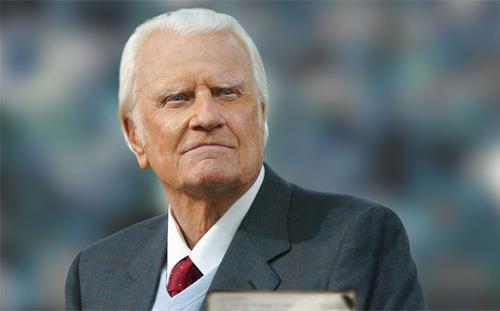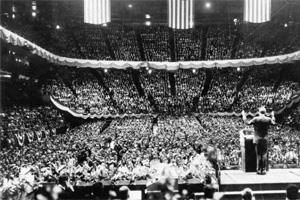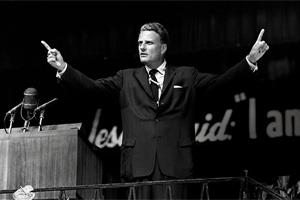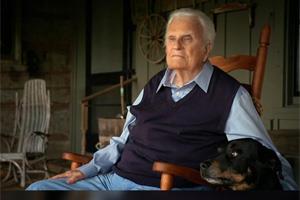
To all the nice things said about Billy Graham since his death Wednesday morning, we probably should add one more: YouTube star.
The late Rev. Graham, who was 99 and widely eulogized as “America’s Pastor,” is represented today on YouTube by videos from the immensely influential trail he blazed more than a half century ago on television.
If you were to say Graham pioneered televangelism as we know it, you wouldn’t get a lot of argument. More than that, he helped demonstrate the potential of television’s broader power.
So while other discussions on Graham’s life and message continue, let’s also remember how he made himself into a nationally known television personality with the sermons we can watch today on YouTube, thanks to the foresight of the Billy Graham Evangelical Association (BGEA).
 I don’t want to overstate his YouTube following. Views range from about 12,000 for his famous 1957 Madison Square Garden (right) crusade to 700,000 for some later rallies that were filmed in color.
I don’t want to overstate his YouTube following. Views range from about 12,000 for his famous 1957 Madison Square Garden (right) crusade to 700,000 for some later rallies that were filmed in color.
Just for perspective, last weekend I joined two granddaughters watching a video by contemporary YouTube star Wengie, titled “15 Toothpaste Hacks You Should Know.” In two and a half months it has 3.36 million views.
Still, I’m guessing the Graham videos may touch a deeper chord, no offense to Wengie, and even though he’s been out of public sight for years, those videos remain the biggest reason Billy Graham became the most popular evangelist of the 20th century.
Television was “by far the most significant [factor] in extending our ministry,” he wrote in 1997.
These days, we take it for granted television has that kind of impact. In 1957, it wasn’t something a lot of people even thought about.
Graham did, to the extent the BGEA bought airtime to telecast its crusades. Exact audience numbers are hard to come by, but the shows had both viewers and buzz. It’s the first show besides Davy Crockett that I remember my family and friends talking about.
So when Graham died, I decided to recall for myself. I went to YouTube and called up a complete hour-long 1958 broadcast from Charlotte.
The black-and-white video has that classic early-TV glare and the images are a little fuzzy. No matter. Within two minutes you know this guy is good.
 He speaks well, he knows how to tell a story and he commands the stage. True, he’d been doing crusades for a decade by this point. But what he’s doing takes more than practice.
He speaks well, he knows how to tell a story and he commands the stage. True, he’d been doing crusades for a decade by this point. But what he’s doing takes more than practice.
He starts slow and accelerates into urgent. He knows when to speed up his words and when to let them soak in. He leans back from the podium. Several times he steps away to the side and speaks into the TV camera, addressing the poor, the sinners, the lonely.
The staging says theological royalty. Graham stands on an elevated podium behind several rows of elaborate floral arrangements. The Charlotte Coliseum is packed, 13,000 of the faithful in folding chairs and reverent silence.
The message is a mix of the New and Old Testaments, the love of Jesus juxtaposed with the sharp admonition that if we don’t heed His message, we are all doomed.
The week of Jesus’s crucifixion was the darkest time in human history, Graham declares, and because humans have not stopped sinning today, “We are just as guilty as Judas” of betraying Jesus. “We are on the brink of hell.”
Graham judiciously sprinkles secular references into the theology. We have terrible problems today, he says: “the race problem, the problem with communism, the problem of crime that gets worse each day.”
 He denounces communism and crime. He calls a recent synagogue bombing evil. On “the race problem,” he says it isn’t just a Southern problem. He also says everyone is equal in the eyes of God.
He denounces communism and crime. He calls a recent synagogue bombing evil. On “the race problem,” he says it isn’t just a Southern problem. He also says everyone is equal in the eyes of God.
He refers to America as “a Christian nation,” a phrase on which many subsequent televangelists have doubled down. These days, it can be more pejorative.
In any case, the Charlotte Crusade remains a virtuoso performance, though Graham neither invented any or it nor claimed to.
Preachers of all races and religions have employed this style for millennia. Protestant evangelism in particular, back to the Puritans, has never been “I’m okay, you’re okay.” It’s tough love with time running out.
In more modern times, preachers were delivering this ominous message on the radio when Billy Graham was a toddler. Father Coughlin in the 1930s was only the most prominent among hundreds of radio preachers.
Graham himself got his start on radio, delivering sermons on a Christian show called Songs in the Night. In 1950 he started his own program, Hour of Decision, which would run for six decades even after he got too busy to do it in 1954.
Brushing aside the apprehension of some colleagues, Graham enhanced his television profile with regular appearances on talk shows. He was the mystery guest one night on What’s My Line. NBC offered him a network show of his own, which he turned down to continue the crusade sermons we can still see on YouTube.
If you want to understand why Billy Graham’s death was a big deal, watch one.